The last (almost) three years have been full of change, uncertainty, and innovation - particularly as it relates to the job market and how people work.
Many companies realized they could facilitate remote work and maintain (if not improve) productivity during the COVID-19 pandemic. Many organizations implemented hybrid working programs over the past couple of years, however, 85% of leaders say the “shift to hybrid work has made it challenging to have confidence that employees are being productive,” according to a 2022 Microsoft survey. More and more states have passed laws around pay transparency, including Colorado, New York, California, Washington, and Rhode Island, with more expected to follow.
Following nationwide protests in 2020, many companies made big promises to focus on and improve diversity, equity, inclusion and belonging (DEIB). And while some companies are leading the way on this front, roughly 80% are “just going through the motions,” a 2021 study from Josh Bersin suggested.
There’s more focus on mental health, wellness, and work-life balance, especially as the personal and professional lines began to blur around the start of the pandemic. And with long Covid symptoms affecting one in 13 adults in the US (according to a June 2022 Household Pulse Survey, as reported by the CDC), this is unlikely to change.
Mass layoffs in the tech sector, record inflation, high housing costs, and more are turning job hopping into a flight to safety as more workers prioritize job security.
The world of work has evolved rapidly, and as a result, it has forced employers and employees to decide what’s most important to them and why. And with all the recent changes to the way we work (and more on the horizon, particularly with pay transparency compliance), people analytics is more important than ever.
The stakes are high. And quite frankly, any C-suite that chooses to ignore or under-resource their people analytics team will pay the price… literally.
With that in mind, here are the top four talent market trends to keep an eye on in 2023.
1. Pay transparency will continue to gain momentum
Even before pay transparency laws were a thing, employees had been pressuring companies to be more open about compensation. Whether it was a desire to avoid wasted time during the application and interview process or an effort to address gender pay discrepancies, pay transparency is not a new concept. Far from it.
However, there’s no question that it’s gaining momentum with more than a dozen cities and states passing pay transparency laws in the last several years. We’ve also seen this trend playing out in job postings.
By December 2022, there were 3.7 million job postings that include salary information, which was 37% of the total 9.9 million job postings in the US, according to data from Claro Analytics. And the overall ratio of new job postings with salary data is trending higher and increased from 28% to 37% in 2022. 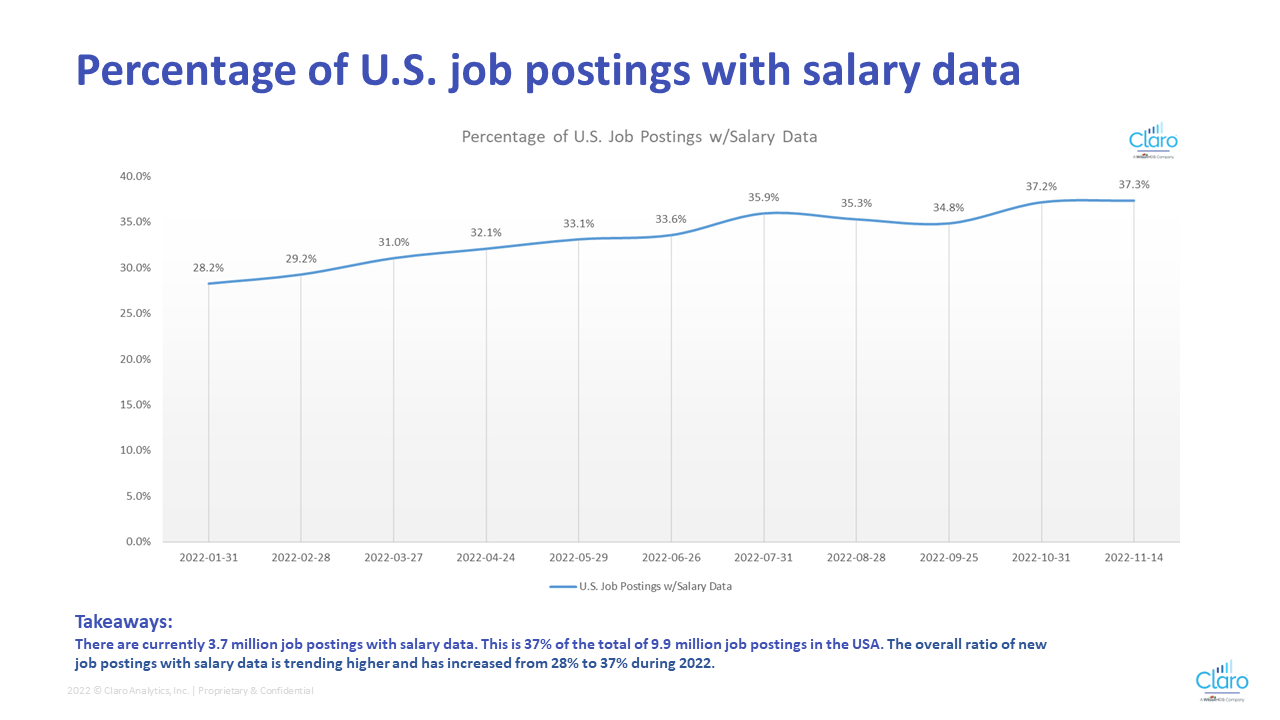
California, Rhode Island, and Washington implemented pay transparency laws on January 1, so this ratio is only expected to grow.
2. Diversity, equity, inclusion and belonging (DEIB) will remain a priority
It’s no secret that having a diverse workforce is culturally and financially beneficial, and studies show diverse teams are more innovative and creative. As a result, more companies are boosting DEIB initiatives into their business strategy, especially as it pertains to retention and recruiting new talent.
Here’s what that looks like in job posting data, e.g. how many US job postings mention “diversity,” “equity,” and/or “inclusion.” Our data shows 1.4 million job postings between January 1, 2022 and November 14, 2022 mention one or all of those words, which is 14.3% of the total 9.9 million US job postings.
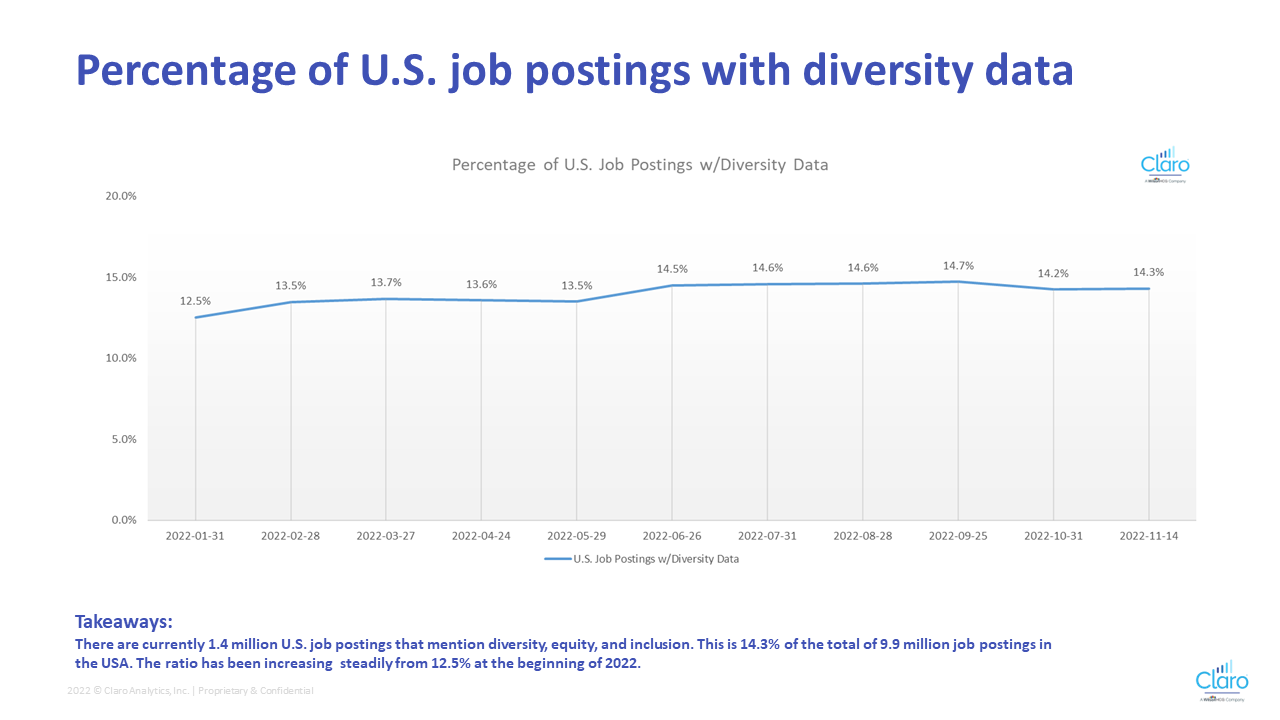
While this data doesn’t tell us exactly how companies are implementing DEIB within their organizations, it does indicate that more companies are focusing on it and sharing it publicly as a value. For people analytics teams, this can be valuable information in terms of benchmarking against competitors, and this info can help talent acquisition teams when crafting recruitment marketing material and job posts.
3. Flexible/remote work will continue be a key driver for candidates
The number of workers in the US who work from home tripled between 2019 and 2021, according to the US Census Bureau. While the remote work boom initially started because of the COVID-19 pandemic, many employees are looking to stay remote or work a hybrid schedule. Almost half (48%) of US workers said they will "definitely" look for a remote position for their next job, a recent survey from SHRM revealed.
On the flip side, many employers are requiring employees to come back to the office. Most notably, Disney CEO Bob Iger recently released a memo telling hybrid employees they must return to the office four days a week starting March 1, according to an article on CNBC. Starbucks CEO Howard Schultz also issued a memo this month (as reported in Business Insider) requiring employees who live within commuting distance of the Seattle headquarters to come in three days a week.
So it’s hard to predict which way this trend will go. Who will win the remote work tug-of-war: employees or employers? Based on Claro Analytics job postings data, the number of postings that mention flexible working arrangements decreased slightly in 2022, from 6.7% of total job postings to 6.2% (or 615,000 postings).
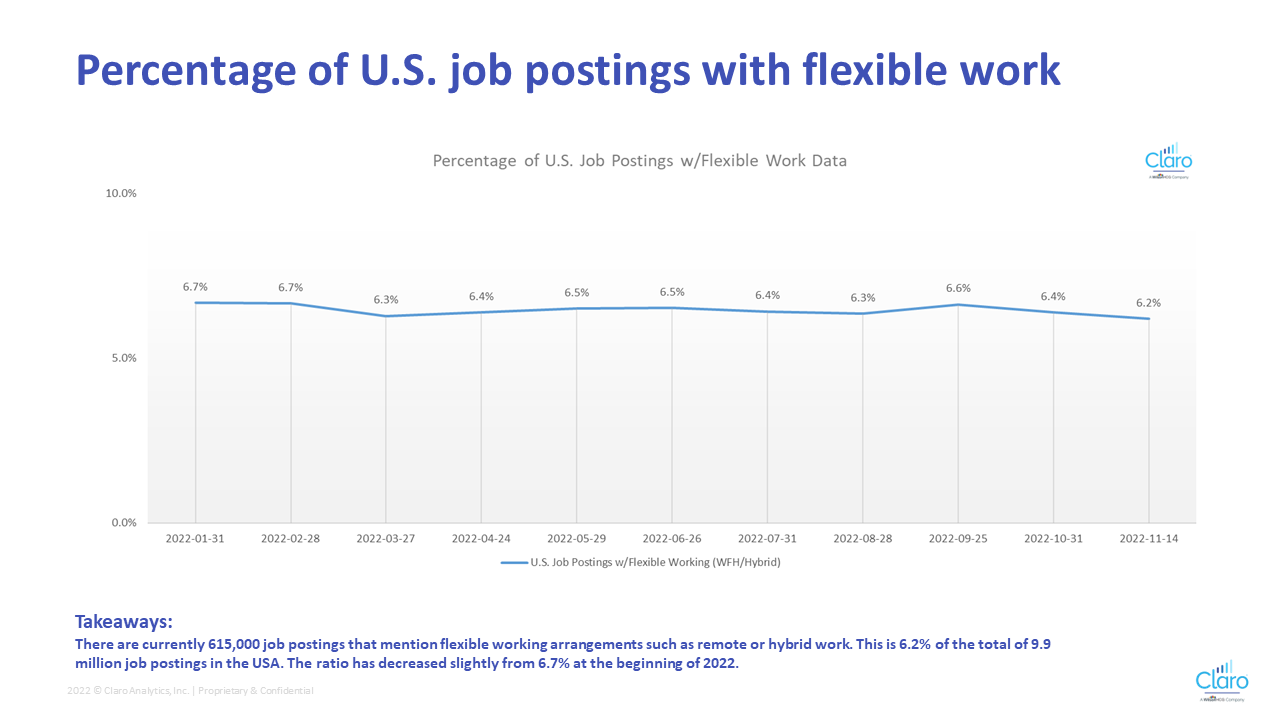
Tracking mentions of flexible work options in competitors’ job postings could be highly beneficial for people analytics teams looking to advise their executive team on remote or hybrid work.
4. Mental health: Candidates want to work for companies that care (literally)
Between the COVID-19 pandemic, social justice issues, the Russia-Ukraine war, increasing environmental issues like wildfires and hurricanes, political unrest, and more, the compounding toll on workers' collective mental health has been significant over the last few years. And mental health challenges don't stop when workers step into the office or open their laptop.
According to a 2021 survey on mental health at work by Mind Share Partners, 76% of respondents said they experienced at least one symptom of a mental health issue that year. And 50% of full-time US workers said they left a previous job partly due to mental health reasons.
While many companies say they have bolstered their mental health benefits, Claro Analytics data indicated very few are mentioning it in their job postings. As of December 2022, only 45,000 job postings mentioned mental health and wellness programs, which is only 0.5% of the total 9.9 million job postings in the US.
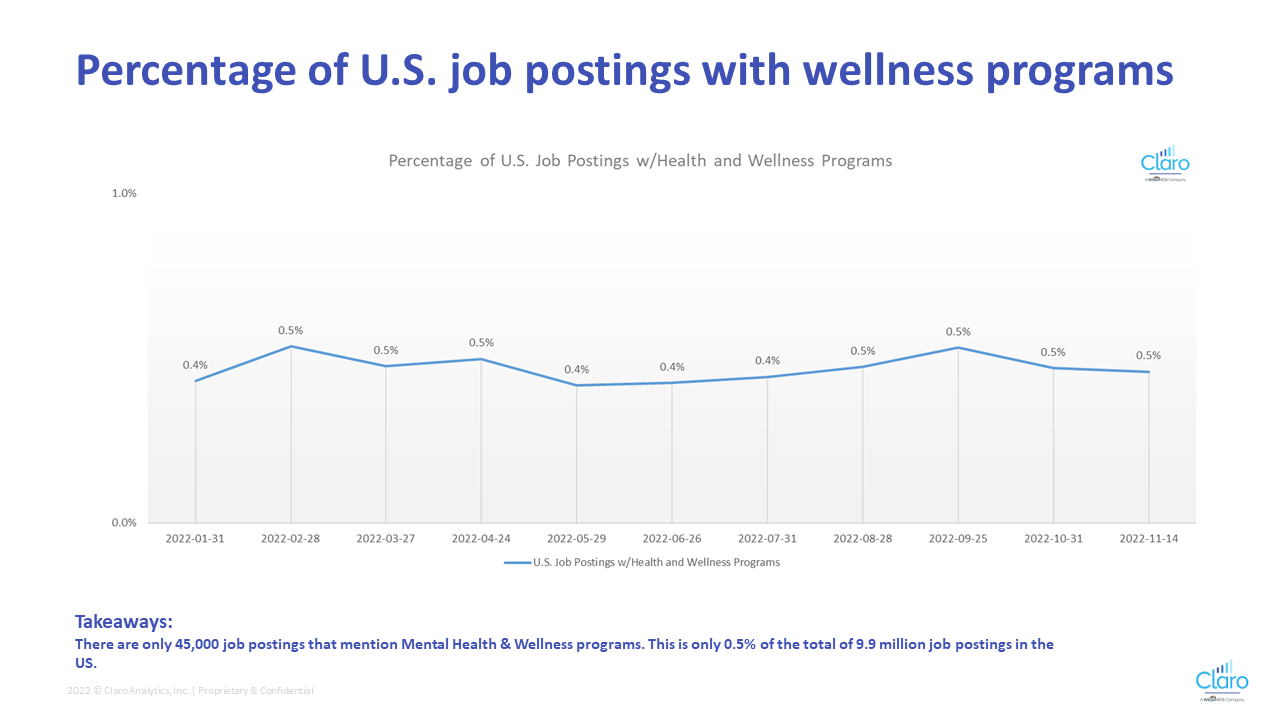
While mentions of mental health and wellness may be low now, it will be interesting to track this trend in 2023 to see if more companies offer these programs, and if so, will they include them in job postings? Employees want to work for organizations that care, so mentioning mental health programs can go some way to show candidates that companies do take it seriously.
Conclusion
People analytics teams have a lot on their plates this year, but pay transparency, diversity, flexible work options, and mental health are four trends every people analytics team should keep an eye on this year. Comparing internal data to real-time external data (like job postings) can help people analytics teams benchmark where their company is at and compare it to competitors. Plus, being mindful of these four trends can help companies stand out from their competitors while also ensuring they are offering a compelling employee value proposition.
